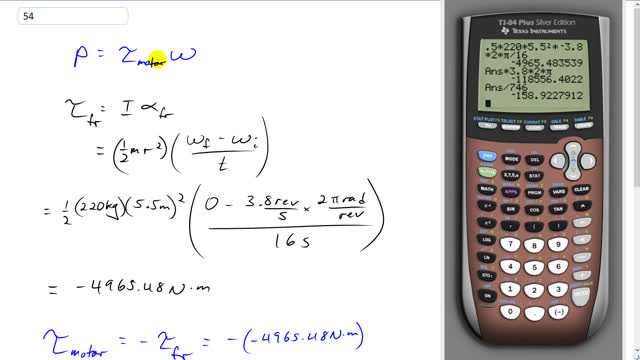
A rotating uniform cylindrical platform of mass 220 kg and radius 5.5 m slows down from 3.8 rev/s to rest in 16 s when the driving motor is disconnected. Estimate the power output of the motor (hp) required to maintain a steady speed of 3.8 rev/s.

In order to watch this solution you need to have a subscription.
This is Giancoli Answers with Mr. Dychko. The power output of the motor will equal the torque it applies times the constant angular velocity of 3.8 revolutions per second. And the torque the motor applies will have to equal the frictional torque since it's maintaining a constant speed. So we'll figure out what the frictional torque is based on this data that tells us that when the motor is disconnected, it slows down from 3.8 to rest in 16 seconds. So we'll find the frictional torque by going moment of inertia multiplied by that angular acceleration. So moment of inertia of a uniform solid cylinder is one-half mass times its radius squared times its final angular velocity minus its initial divided by time. So that's one-half times 220 kilograms times 5.5 meters radius squared and then times—well, 0 is the final angular velocity—so that minus 3.8 revolutions per second converted into radians per second by multiplying by 2π radians per revolution and divide by 16 seconds and that gives us negative 4965.48 newton meters is the frictional torque and that will be true regardless of what the speed is of the cylinder. So the torque applied by the motor is gonna be opposite to the torque applied by friction so we'll take the motor to be positive in the end and then multiply that by the angular speed that it has to maintain 3.8 revolutions per second converted into radians per second again. And then times by 1 horsepower for every 746 watts to get our answer in horsepower: that's about 160 horsepower.